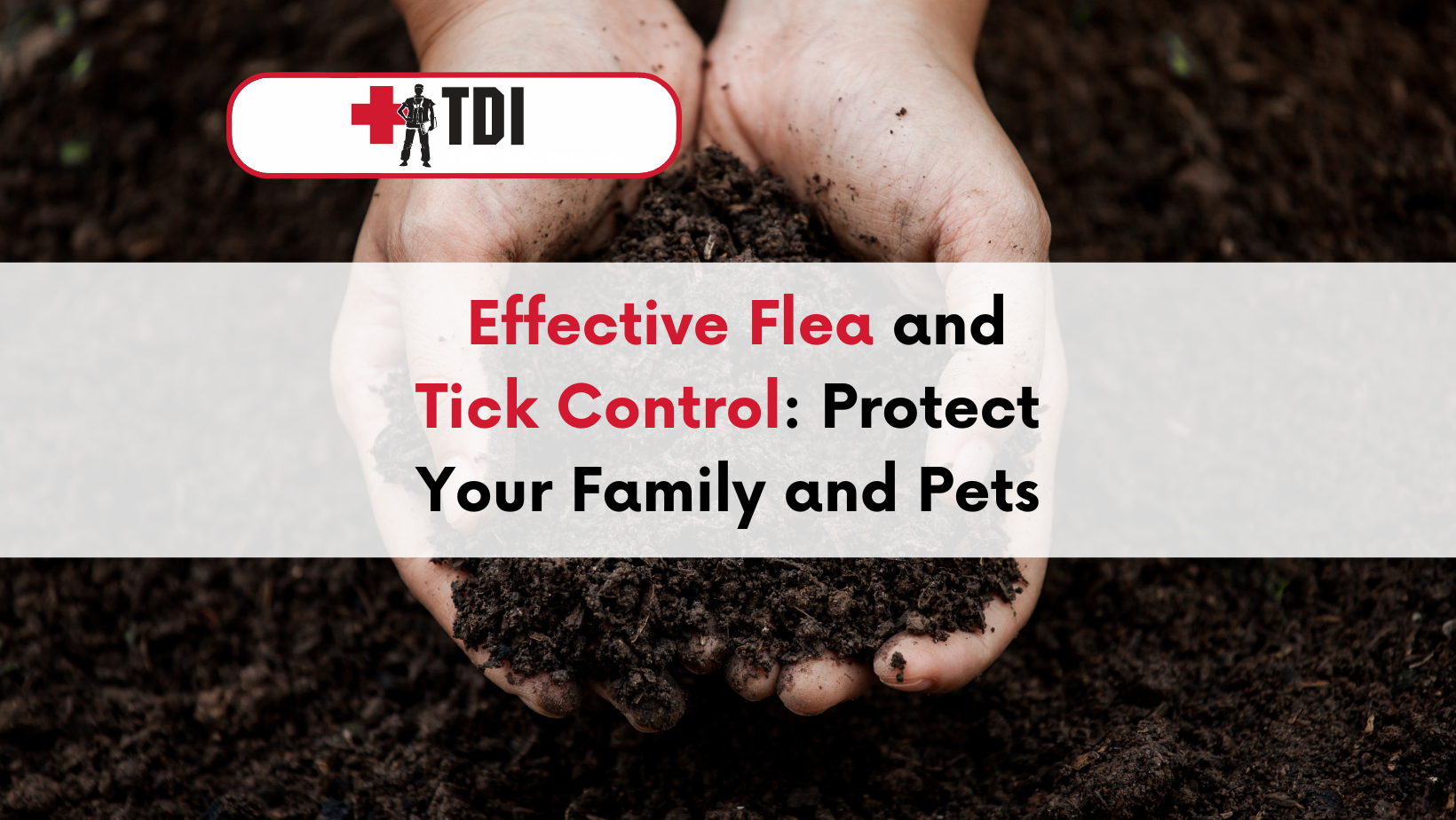
Warm weather often means more time outside, but it also brings unwanted guests: fleas and ticks. These pests can cause discomfort and health problems for both your family and pets. Fleas are notorious for infesting homes and causing itchy bites, while ticks can transmit serious diseases such as Lyme disease.
Effective flea and tick control is crucial for a happy and healthy environment. Understanding their life cycles and taking preventive measures can significantly reduce the risk of infestations. Regular inspection of your pets, home, and yard can help catch these pests early. Using appropriate treatments and practicing good hygiene are key steps in protecting your loved ones.
In this comprehensive guide, we’ll explore various strategies for controlling fleas and ticks. We’ll cover preventive measures, how to treat infestations, and the best ways to maintain a pest-free home and yard. With the expertise of TDI Services, a leader in biological lawn, mosquito, pest, and termite control, you’ll be better equipped to safeguard your family and pets from these bothersome pests. Let’s dive into the essentials of effective flea and tick control to ensure a comfortable and safe living space for everyone.
Understanding Flea and Tick Infestations
Environmental factors play a major role in flea and tick infestations. Living close to woods, open fields, or areas with high wildlife activity increases the risk. Pets that spend time outdoors can carry these pests inside, leading to quick infestations. Fleas can easily jump onto people or pets, spreading rapidly to carpets and upholstery. Ticks pose serious health threats, as they can carry Lyme disease and Rocky Mountain Spotted Fever. It’s essential to manage these pests to protect your family and pets.

Importance of Treating Your Lawn
Fleas can easily thrive in your lawn and move indoors. Treating your lawn helps reduce the chance of indoor infestations. Fleas like to hide in shady, moist areas, making lawns an ideal breeding ground. Regular mowing, raking, and removing lawn debris helps create an environment less inviting to fleas.
Using safe and effective treatments on your lawn is crucial. Treatments that target adult fleas, larva, and eggs ensure comprehensive control. TDI Services uses targeted preventive applications, creating a barrier that keeps fleas at bay.
Managing Indoors: Carpets and Upholstery
Once fleas enter your home, they quickly infest carpets and upholstery. These pests lay eggs that fall into carpet fibers, making it hard to eliminate them without targeted treatments.
Vacuuming regularly helps reduce the number of fleas. Focus on areas where pets spend time, such as pet beds and sofas. After vacuuming, always empty the vacuum bag outside to prevent reinfestation.
Using insecticide sprays or powders designed for indoor use can eliminate fleas in carpets and upholstery. Follow the product instructions carefully for safe and effective use. Combine these efforts with treating your pets to ensure complete flea control.
Identifying Tick Habitats in Your Landscape
Ticks thrive in specific parts of your landscape, such as tall grasses, shrubs, and piles of leaves. Identifying and treating these areas reduces the risk of ticks entering your home.
Keep your lawn mowed and remove tall grass and leaf piles. Create a barrier between wooded areas and your yard by using wood chips or gravel. This discourages ticks from moving into your lawn.
Treating your yard with appropriate tick control products helps keep these pests away. TDI Services applies effective treatments to bedding areas and lawns, reducing tick populations and lowering disease risk.
Comprehensive Treatment Plans
Dealing with an infestation requires more than just treating one part of your home or yard. A comprehensive plan ensures that all areas where fleas and ticks could be hiding are addressed.
TDI Services provides exterior applications to your lawn and bedding areas as a preventive measure. If an infestation is present, treatments to both the exterior and interior of your home are required. Treat your pets according to your veterinarian’s recommendations to prevent them from bringing fleas and ticks back indoors.
Recognizing Symptoms of Flea and Tick Bites
Identifying flea and tick bites early helps you take quick action. Flea bites often appear as small red bumps that itch intensely. They usually appear on the lower legs or where the skin is more exposed.
Tick bites can be harder to spot since ticks attach themselves to the skin and may not cause immediate symptoms. Look for a small bump or redness around the bite site. Ticks can remain attached for several days, so inspect your pets and family members after spending time outdoors.
If bitten, clean the area with soap and water. Remove ticks with tweezers, ensuring the entire tick is removed. Seek medical attention if symptoms like fever, rash, or joint pain develop, as these can indicate tick-borne diseases.
Preventive Measures for Pets
Pets are often the primary carriers of fleas and ticks in your home. Regular preventive measures help protect both your pets and your family.
Use veterinarian-recommended flea and tick treatments for your pets. These may include topical treatments, oral medications, or collars that repel and kill fleas and ticks. Regular grooming and inspections help catch pests early.
Wash your pet’s bedding frequently and vacuum areas where they spend time. Keep pets away from tick-prone areas, such as tall grasses and wooded areas, to reduce exposure.
Safe Use of Chemical Treatments
While chemical treatments are effective for controlling fleas and ticks, it’s important to use them safely. Incorrect use can harm pets, family members, and the environment.
Always read and follow the product label instructions. Use the correct dosage and avoid mixing different products. When using sprays or powders, ensure proper ventilation and keep pets and children away from treated areas until they are safe.
Consider integrated pest management (IPM) strategies, which combine chemical treatments with non-chemical methods. This balanced approach reduces the need for frequent chemical applications.
Monitoring and Maintenance
Maintaining a flea and tick-free environment requires continuous monitoring and maintenance. Regular inspections of your home, yard, and pets help catch any signs of pests early.
Vacuum carpets and upholstery frequently and mow your lawn regularly. Inspect pets for fleas and ticks, especially after spending time outdoors. Replace or retreat infested areas as needed to keep your home and yard pest-free.
How to Inspect Your Home for Fleas and Ticks
Regular inspections are key to catching flea and tick problems early. Start by carefully examining your pets. Use a fine-toothed comb to check for fleas, flea dirt, or ticks. Pay special attention to areas like behind the ears, under the legs, and near the tail.
Inspect carpets, rugs, and pet beds for signs of fleas. Flea dirt, which looks like small black specks, is an indication of an infestation. For ticks, check common hiding spots like baseboards and dark corners. Remove any ticks you find indoors using tweezers, making sure to get the entire tick.
Outdoor Measures: Yard Maintenance
Keeping your yard well-maintained significantly reduces the likelihood of flea and tick infestations. Regularly mow your lawn, trim shrubs, and clear leaf litter. This minimizes the habitats where fleas and ticks thrive.
Create a buffer zone between wooded areas and your lawn. Use gravel or wood chips to deter ticks from crossing into your yard. Remove any wildlife attractants, like bird feeders, which can draw flea-carrying animals closer to your home.
Consider adding plants that naturally repel fleas and ticks, such as rosemary, lavender, and lemongrass. These can serve as an extra barrier and help keep these pests at bay.
Pet Grooming and Hygiene
Grooming your pets regularly is essential for controlling fleas and ticks. Bathe your pets with flea and tick shampoos recommended by your veterinarian. These products kill and repel pests while keeping your pet’s coat clean.
Brush your pets often to remove any loose hair and check for fleas and ticks. Regular grooming helps you detect pests early before they become a bigger problem. Keeping your pets’ bedding clean is also crucial. Wash bedding frequently in hot water and vacuum the surrounding areas.

Understanding the Life Cycle of Fleas
To effectively eliminate fleas, it is essential to understand their life cycle. Fleas go through four stages: egg, larva, pupa, and adult. Female fleas lay eggs on the host animal, and these eggs fall off into the environment, such as carpets and pet beds.
Larvae emerge from eggs and feed on organic material, including flea dirt. After feeding, they spin cocoons and enter the pupal stage. Adult fleas emerge from the pupae when conditions are favorable, such as the presence of a host
Since eggs, larvae, and pupae can remain hidden in your home, it is crucial to use treatments that target all life stages. Regular vacuuming and washing of pet bedding help break the flea life cycle.
The Role of Wildlife in Infestations
Wildlife can introduce fleas and ticks into your yard, leading to infestations. Animals like raccoons, skunks, and squirrels can all carry fleas and ticks. To prevent wildlife from bringing these pests close to your home, secure trash cans and remove any food sources that attract animals.
Install fencing or use other barriers to keep larger mammals away from your yard. Removing bird feeders and nesting boxes can also help, as birds can carry ticks. Managing the presence of wildlife in your yard reduces the risk of fleas and ticks finding their way into your home.
Effects of Weather on Flea and Tick Activity
Weather conditions significantly impact flea and tick activity. Warm and humid weather creates ideal conditions for fleas to thrive, while ticks are most active in spring and summer. Understanding these patterns helps in planning preventive measures.
During peak seasons, increase the frequency of yard treatments and pest inspections. Monitor weather conditions and adjust your flea and tick control strategies accordingly. By staying ahead of the weather, you can minimize the risk of infestations.
Integrated Pest Management
Integrated Pest Management (IPM) is an effective approach to controlling fleas and ticks. IPM combines multiple strategies, including cultural, physical, and chemical methods, to manage pests sustainably.
Cultural methods involve modifying the environment to make it less hospitable to fleas and ticks. Physical methods include removing pests by hand and using traps. Chemical methods involve using safe pesticides when necessary.
Using IPM reduces the reliance on chemicals and promotes long-term control of fleas and ticks. Regular monitoring and adjusting strategies based on pest activity ensure effective control.
Treating an Existing Infestation
When facing an existing infestation, it is vital to treat all affected areas simultaneously. Start by treating your pets with veterinarian-recommended flea and tick products. Follow up with treatments for your home and yard.
Apply insecticides to carpets, upholstery, and pet bedding according to product instructions. For outdoor areas, use treatments that target flea and tick habitats, such as lawns and shrubs. Maintain regular cleaning and grooming routines to support the effectiveness of these treatments.
TDI Services offers comprehensive treatment plans that include exterior and interior applications, ensuring thorough coverage and protection. Our treatments are guaranteed for 90 days, giving you peace of mind and effective control of fleas and ticks.
Safe Storage and Application of Pest Control Products
Proper storage and application of pest control products ensure their effectiveness and safety. Always store chemicals in their original containers, away from children and pets. Keep them in a cool, dry place to prevent degradation.
When applying products, follow the instructions carefully. Use protective gear like gloves and masks if recommended. Ensure proper ventilation when using indoor sprays or powders. Avoid applying products near food preparation areas to prevent contamination.
Dispose of empty containers and unused products according to local regulations. Safe handling and storage practices protect your family, pets, and the environment.
Monitoring Results and Follow-Up Treatments
After applying flea and tick treatments, monitor results closely. Check pets, carpets, and outdoor areas for any signs of lingering pests. If you notice continued activity, a follow-up treatment may be necessary.
Consistent monitoring helps identify any new infestations early. Reapply treatments as recommended to maintain control over fleas and ticks. Regular follow-up ensures that the problem remains under control and prevents future outbreaks.
Natural Remedies for Flea and Tick Control
Many pet owners prefer natural remedies for controlling fleas and ticks. These options can be less toxic and safer for pets and humans. Essential oils like lavender, eucalyptus, and cedarwood have pest-repellent properties. You can make a spray by diluting these essential oils with water and applying it to your pet’s fur.
Diatomaceous earth is a natural powder that can be sprinkled on carpets, pet bedding, and in your yard. This fine powder dehydrates and kills fleas and ticks. Make sure to use food-grade diatomaceous earth and keep it away from your pet’s face and eyes.
Another natural option is nematodes, tiny worms that feed on flea larvae. You can release them in your garden to help reduce the flea population. Using natural remedies as part of your overall flea and tick control strategy can offer additional protection.
Protect Your Home and Loved Ones from Fleas and Ticks
Ensuring your home and yard are free from fleas and ticks is essential for the health and comfort of your family and pets. Regular inspections, proper grooming, and maintaining a clean environment are key practices. Understanding the habits and life cycles of these pests enables you to adopt effective preventive measures and treatments. Combining natural remedies with professional services can offer comprehensive protection.
At TDI Services, we specialize in targeted Flea & Tick treatments that safeguard your home and outdoor spaces. Our exterior and interior applications tackle infestations from all angles, providing comprehensive coverage. Guaranteed for 90 days, our treatments ensure peace of mind by addressing and preventing the recurrence of pests.
Don’t let fleas and ticks disrupt your life or harm your loved ones. Trust TDI Services to offer expert solutions tailored to your needs. For effective and eco-friendly pest control solutions, contact TDI Services today and take the first step towards a pest-free home. Protect your family, pets, and property with our proven expertise in flea and tick management.
